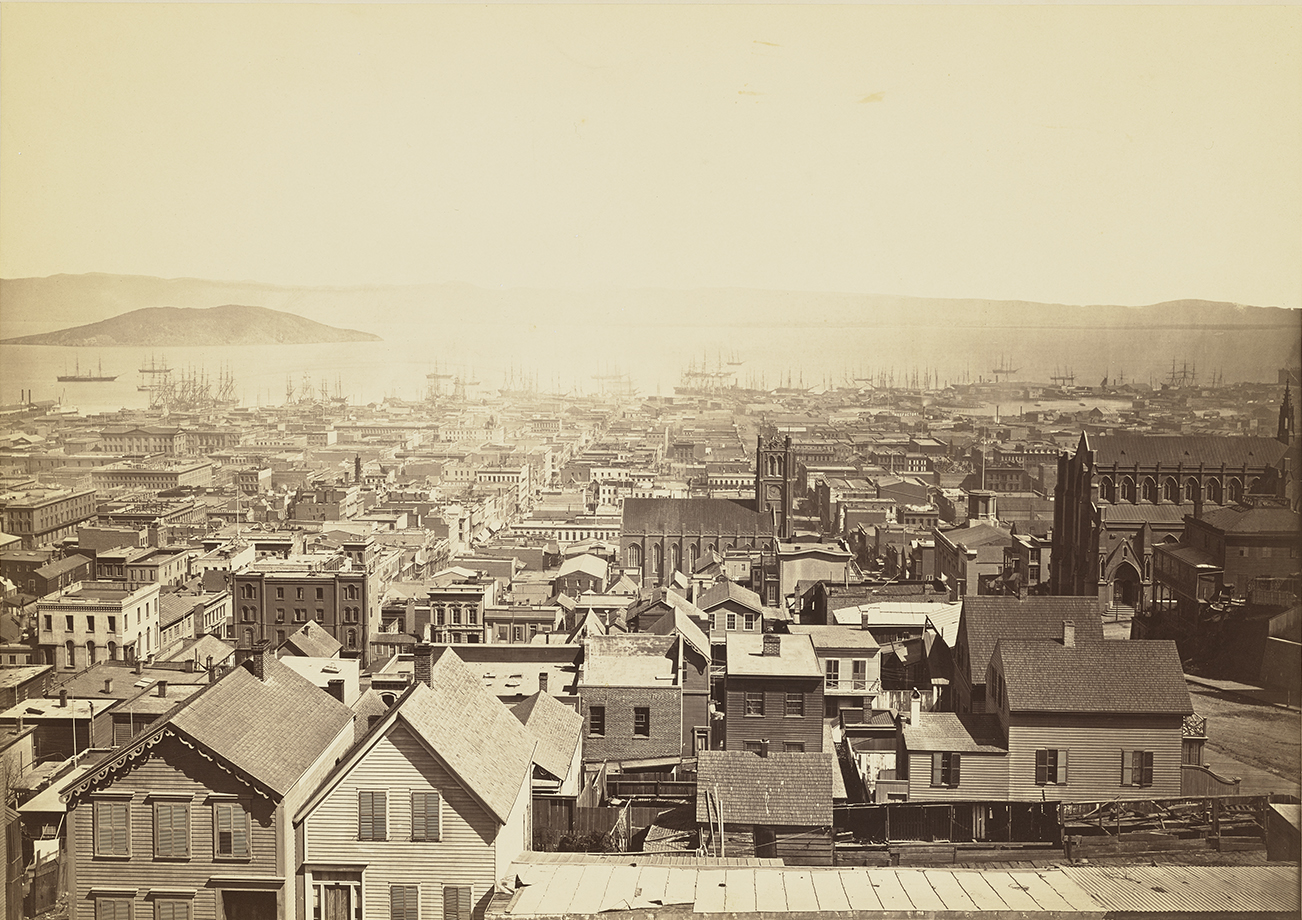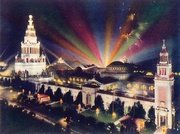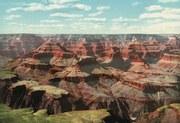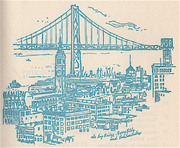
A 1925 photo by Rovere Scott shows the Golden Gate passage before its famous bridge was constructed. Courtesy the California Historical Society.
In 1851, a few years after the start of California’s Gold Rush, an unknown photographer assembled their equipment on a small hill near the port of San Francisco. Working carefully in the bright afternoon light, they created a panoramic series of daguerreotypes depicting the waterfront neighborhood with its scenic natural backdrop. The resulting set of shadowy, bronze-tinted images comprises some of the earliest photos taken in the storied new state of California, and gave many curious Americans back east their first impressions of the city by the bay. While these daguerreotypes captured some of San Francisco’s most memorable quirks—yes, there are hills—they also revealed aspects of the young city that aren’t part of its legend, like the way urban and rural lifestyles intertwined on unpretentious blocks, or the drama of its wild, sandy bluffs overlooking a harbor packed with wooden vessels.
“Who does the city belong to? What is it for?”
Today, millions of digital images are created and shared on a daily basis, but in the 1850s, a single daguerreotype took a skilled professional with expensive supplies considerable time to photograph and develop for display. The final image was unique, and could not be copied or reprinted. Relying on early photographs like these, the California Historical Society’s recent exhibition, “Boomtowns: How Photography Shaped Los Angeles and San Francisco” offers a detailed look at the formation of California’s two largest cities from the mid-19th to the early 20th centuries. (The show is on display through March 2019.)
Viewing such detailed early images of San Francisco and Los Angeles, cities famous across the globe, is like meeting a friend’s parents for the first time: The photos instantly deepen our understanding of these places and how they came to be. Taken together, the collection emphasizes the near-constant upheaval and seismic change both cities experienced during these decades and in the years since.

Three daguerreotypes from a seven-part panorama of San Francisco taken by an unknown photographer in 1851. Courtesy the California Historical Society. (Click to enlarge)
The exhibition opens with six surviving images from the panorama of San Francisco taken in 1851. Framed in brass mats, the photos are elusive, as the metallic sheen of their coated-glass surfaces makes the images invisible if not viewed from the perfect angle—one can only see a single section of the panorama at a time, a small slice of the mysterious city of San Francisco. These elusive images were likely shipped to the East Coast, where they would have gone on display for a paying public. (Individual daguerreotypes were typically held in one’s hands for viewing, so a panoramic wall-mounted view would have been a novelty to most viewers.)
“For many people who saw it back east, the daguerreotype panorama of the waterfront would have been the first time they had seen this crazy, mythical place called California that was so full of possibility,” explains Erin Garcia, managing curator at the California Historical Society. “They would’ve seen all those ships in the harbor and the empty plots of land. They would’ve seen houses—temporary, prefabricated houses—but lots of houses nonetheless. It would have given them some idea of the opportunities that California and specifically San Francisco would’ve offered. Maybe it suggested that there was more civilization here than you might expect in Gold Rush California.”

Detail of a daguerreotype image of San Francisco taken by an unknown photographer in 1851. Courtesy the California Historical Society. (Click to enlarge)
In many ways, the flowering of photography was intimately entwined with the early development of California’s biggest cities. A century before the state became famously linked with the technology industry, local inventors were experimenting with photographic devices, creating images unlike any seen before. Innovators like Eadweard Muybridge and Carleton Watkins pushed the limits of the medium while documenting everything from the state’s majestic landscapes to its emerging urban culture.
“I think the earliest and best example of Californians pushing the limits of photography is probably Carleton Watkins having a custom-made, cabinet-sized camera built to take with him to Yosemite in 1861,” Garcia says. “The literature suggests that he wanted his photographs to be hung on walls, to be framed and viewed like large paintings. There was no way to enlarge a photo at the time, so the way you got a bigger picture was to use a bigger negative. And to get a bigger negative you had to have a bigger camera, so Watkins used this gigantic custom-made camera with glass plates he had to haul all the way to Yosemite. It was just so absurd.”
Besides carrying unwieldy equipment out into the California wilderness, Watkins would have had to coat each massive glass plate with a sticky collodion solution and develop them in his darkroom tent. Watkins also captured panoramic shots of San Francisco; the resulting mammoth-plate albumen prints, at around 14 inches high by 20 inches wide, give firsthand viewers an impressive window into the period that can’t be replicated by copies online or in print.

“Panorama (3 of 5): View Towards Goat Island, San Francisco,” a mammoth-plate albumen print by Watkins from 1864. Courtesy the California Historical Society. (Click to enlarge)
Meanwhile, Muybridge was working to perfect complex panoramas and improve shutter speeds so he could stop motion entirely. “The technology that he pushed, it’s just absolutely incredible,” Garcia says. “We have a 360-degree panorama on view taken from the Mark Hopkins residence on Nob Hill. Muybridge had to figure out how to make a 360-degree view, which no one had really done, though there had been some attempts. It was a very tricky thing to do because you would have to divide the horizon into equal parts, and then, on the ground glass, which is showing you a picture upside down, you’d have to somehow get the horizon lines to align. You’d have to manage the sunlight, always keeping the sun at your back so that your camera’s not looking directly into the sun. It would’ve taken many hours, so it was an incredible logistical and technical accomplishment.”
From the moment Mexico ceded California to the U.S., professional photographers used the medium to shape popular conceptions of the state, selling it as the land of opportunity. Beginning with touring exhibitions of glass-plate images, photographs of California traveled far and wide, especially once the business of photography hit its stride in the 1890s, when cameras grew increasingly affordable, photos began appearing in newspapers, and people started sending real photo postcards.
Rumors of verdant fields and streams filled with golden nuggets were illustrated with photographs of bustling San Francisco, the boomtown that grew from its well-protected port along the Pacific Coast, where men and women came to make fortunes and enjoy the spoils of their riches. Others were enticed by Los Angeles’ scenic coastline and temperate climate, as well as its lush gardens and orchards, overflowing with tropical plants year-round.

Panels 4 through 8 of Eadweard Muybridge’s “Panorama of San Francisco from California Street Hill” taken in 1877. Courtesy the California Historical Society. (Click to enlarge)
“Early on, you get this idea of San Francisco as a city of hills, because you have these ambitious photographers like Watkins and Muybridge taking pictures from the top of Nob Hill,” says Garcia. “You get this sense of San Francisco as a very photogenic, jewel-like city filled with vistas and views.”
“We have this assumption that photographs capture things exactly as they are, but obviously the hand of the photographer can do so much to distort what we’re seeing.”
As the growing port city became increasingly notorious for its raucous red-light district, photographers often emphasized its sophisticated urbanity, representing San Francisco as a rising cosmopolitan outpost situated at the furthest reaches of the Wild West. By the 1850s, photographers like George Robinson Fardon were already focusing their cameras on the city’s handsome churches and dignified civic buildings. “In some ways,” Garcia says, “they’re kind of boring photographs, but Fardon was trying to show that San Francisco had permanence and respectability. Especially as you go forward in time, a lot of the photographers attempted to show San Francisco as a metropolis.”
In contrast, the earliest photographic images of Los Angeles often depict a rural outpost in ruin, focusing on the aging Mission San Gabriel or Los Angeles Plaza and the town’s expansive natural environs. Garcia compares these images of the former Spanish settlement to those taken of ancient Roman ruins, documenting grand but faded buildings like the Coliseum or Parthenon.

A photograph of L.A.’s Mission San Gabriel taken by Carleton Watkins around the late 1870s. Courtesy the California Historical Society.
“Los Angeles developed a little bit later than San Francisco, with the coming of the railroad in the late 1800s,” Garcia explains. “As L.A. was starting to actually boom and develop, there’s this push to present it as a semi-tropical paradise, so a lot of the photography starts showing L.A. in ways that highlight the good weather.”
Because weather is difficult to capture, particularly in black-and-white images, the photographs often showed exotic plants or bountiful crops along with captions indicating the photo’s winter setting. Other photographers focused on the potentially fertile—but mostly vacant—landscape awaiting new residents and development. Garcia distills their message into a basic argument about Los Angeles’ appeal: “Come and enjoy the weather, the land, and look at the ocean,” she says. “The different ways of visualizing the two cities happened pretty early on.”

Looking north up Broadway from Third Street in downtown Los Angeles, photo taken by Putnam and Valentine. Courtesy the California Historical Society. (Click to enlarge)
Many of the California Historical Society’s photographs present bizarre alternate realities for the cities we think we know so well. In Los Angeles, we see Broadway’s downtown streetscape, orderly and bustling before its long decline (and more recent resurgence); vast expanses of treeless hillsides not yet covered with enormous homes and eternally green yards; and endless rows of oil derricks lining streets where quiet residential neighborhoods exist today. In San Francisco, there’s the private residential enclave known as South Park, now a mix of tech offices, cafes, and modern lofts; Washerwoman’s Lagoon, later transformed into the extravagant world’s fairgrounds for the Panama Pacific International Exhibition, before development into today’s tony Marina neighborhood; and of course, the Bay’s scenic Golden Gate passage, with no evidence of its iconic future bridge (see top image).
With their jarring displacements, these images act like portals to another world: The locations are barely recognizable, but they remind us of how we got here, how early San Franciscans and Los Angelenos shaped the streets and neighborhoods we take for granted today. “L.A. was a wooden-built Victorian city, the neighborhoods were anyway, and we never think of L.A. that way,” Garcia points out. “And San Francisco was a Spanish adobe village at one time, but we rarely think of San Francisco that way, except for Mission Dolores.”
“We tend to think of San Francisco as so planned and beautiful and jewel-like,” Garcia continues, “but it was really just this mess of development. San Francisco was burned and rebuilt many times, even before the 1906 earthquake. It wasn’t really any less or more thought out than L.A., it just happened on a more compact scale.”

Cutting through Second Street, San Francisco, taken by T.E. Hecht in 1869. Courtesy the California Historical Society.
Several of the show’s photos explicitly capture this physical evolution of the urban landscape. “The one that comes to mind is the Minor White image of a little row house in the 1940s Streamline Moderne style next to sand dunes,” Garcia says. “It’s shocking for San Franciscans to see because we’re so used to houses in the city being so tightly packed, shoulder to shoulder, with nature being pushed to the very last block next to the ocean.
“I also think of the Hollywoodland image from 20-some years before, where the Hollywood Hills are just barely dotted with one street lamp,” she continues. “You can just make out some curvy, winding streets and a few custom, beautiful homes, and then, of course, the Hollywoodland sign. If it wasn’t for that sign, we wouldn’t recognize the area at all.”

Sunstream Home at 1958 42nd Avenue at Pacheco Street, San Francisco, taken by Minor White in 1949. Courtesy the California Historical Society.
Other images show the transformation even more dramatically, as with T.E. Hecht’s 1869 images of the hillside removal along San Francisco’s Second Street, the Cardinell-Vincent Co.’s 1916 photo of the demolition of Festival Hall at the San Francisco world’s fair, or C.C. Pierce’s 1917 photos of downtown Los Angeles with several high-rise buildings mid-construction.
Most photos in the exhibition were shot by professionals for a specific purpose, even those taken after the rise of amateur photography in the 1890s. Several were used as the latest tool for public relations and civic boosterism, rallying residents around common goals and encouraging emigrants and entrepreneurs to claim these emerging cities as their home. For example, less than a decade after San Francisco’s devastating 1906 earthquake and fire, stunning photos of the lavish Panama Pacific International Exhibition were used to create a tourism frenzy.

This photo of the Hollywoodland development in L.A. was taken in the late 1920s by an unknown photographer. Courtesy the California Historical Society.
Beyond good P.R., photos also helped to quite literally sell the two cities by advertising real estate. “Developers were using photography like the Hollywoodland pictures,” Garcia says, “which were almost certainly used in promotional materials and publicity.”
Some photos were explicitly produced as fine art (a realm in which the photograph’s role was still being challenged and debated), such as the photos taken by Minor White or Ansel Adams.

Telegraph Hill photographed by Laura Adams Armer around 1910. Courtesy the California Historical Society.
“They both approached photography as an art form with a very specific Modernist aesthetic,” Garcia says. “The Laura Adams Armer and the Arnold Genthe photos were also made as art, but in the pictorialist style predating Modernist photography. They were all concerned with how the elements in the photograph laid out in the frame of the picture. The pictorialists used a hazy, soft-focus style as opposed to that sharply focused Modernist style, and were very much thinking about the photograph in painterly and compositional terms.”
Like many art photographers around the turn of the century, Armer got her start taking photos in a portrait studio, although her cityscapes reveal a keen eye for capturing the emotional impact of quiet moments in the public sphere. “They’re intimate in a sense that, even though they’re outdoors, the subjects are going about their private lives,” Garcia says. “Their guard seems down.”
Though the deliberate aesthetic of artist-made photographs is often clear at first glance, even so-called documentary photos were carefully altered by their creators. This includes the 1869 panorama of Los Angeles taken by Stephen Rendell, which shows evidence that the photographer edited himself out of the final print.

Part of Stephen Rendell’s panorama of Los Angeles looking east from the hillside above Broadway, 1869, later rephotographed by C.C. Pierce. Rendell may have removed himself from the right of the building in the foreground. Courtesy the California Historical Society, USC Libraries Special Collections, Title Insurance and Trust, and C.C. Pierce Photography Collection, 1860- 1960. (Click to enlarge)
“I’m positive that a lot of these photographs were manipulated, but I think that we don’t usually see it,” Garcia says. “For the Panama Pacific International Exposition, we have a lot of photographs used in press materials that were heavily painted in to change the sky so that when printed in the newspaper, they would be graphic enough to really pop.
“We have this assumption that photographs capture things exactly as they are,” Garcia adds, “but obviously the hand of the photographer can do so much to distort what we’re seeing.”
One of the exhibition’s most recognizable photos is an overhead panorama of San Francisco taken by photographer George Lawrence days after the 1906 earthquake and fire. Lawrence used a device he dubbed a “captive airship” to take images from high above the ground, creating skyline views like none had ever seen. After a dangerous fall from a hot-air balloon, Lawrence developed this system using a series of linked kites to raise his cameras into the air, a technology Garcia likens to “drone photography,” albeit more than a century ago.
While Lawrence’s photo might be familiar due to its frequent reproduction, seeing the physical print heightens its impact. This particular image is 18 inches high by 68 inches wide, and its wide-angle view above the Embarcadero piers follows the city streets as they trace across the peninsula, punctuated by sunshine reflecting off the San Francisco Bay. It’s as though you’re looking at a virtual rendering of the disaster—a bleak urban landscape in smoldering ruins seen in near-perfect resolution, the destruction somehow amplified by the day’s near-perfect weather.

“San Francisco in Ruins from Lawrence Captive Airship; 200 Feet above San Francisco Bay, Overlooking Water Front, Sunset over Golden Gate,” photo taken by the George R. Lawrence Co. in 1906. Courtesy the California Historical Society. (Click to enlarge)
Perhaps the most beguiling element of these historic photos is the way they capture anonymous people, forgotten moments in their lives preserved on paper and glass. “In the daguerreotype panorama, it’s striking to me that there are actually several figures visible,” Garcia says, since most images from this era include few humans because they required such long exposures that moving objects were often reduced to a blur. “Some of them have their backs to the waterfront, and they’re looking back to whatever hill the photographer is standing on,” she adds. “I just think it’s so remarkable.”
The effect is heightened for images with oversized prints, like those of the 1906 disaster, which give it a vivid, haunting presence. Most modern viewers have heard plenty about San Francisco’s Great Earthquake, but in a year when wildfires have devastated much of the Golden State, seeing the faces of long-ago San Franciscans staring across the city as plumes of smoke arise from their homes and businesses, the tragedy feels surprisingly immediate. We know the acrid smell of that smoke and the fear it inspired, even among those watching from a safe distance.
In their best moments, these photos puncture our familiar legends with sharp glimpses of black-and-white reality, challenging stereotypes about the two cities. “I hope one thing that comes through in this show is that they are constantly changing,” Garcia says. “These cities are layered, and it’s always been a contest: Who does the city belong to? What is it for? How is it being used?”

“Looking Down Sacramento Street,” photo taken by Arnold Genthe, 1906. Courtesy the California Historical Society, gift of Albert M. Bender. (Click to enlarge)
(“Boomtowns: How Photography Shaped Los Angeles and San Francisco” was on view at the California Historical Society in San Francisco in 2019.)

 In Living Color: The Forgotten 19th-Century Photo Technology that Romanticized America
In Living Color: The Forgotten 19th-Century Photo Technology that Romanticized America
 From Rubble to Riches: The World's Fair That Raised San Francisco From the Ashes
From Rubble to Riches: The World's Fair That Raised San Francisco From the Ashes In Living Color: The Forgotten 19th-Century Photo Technology that Romanticized America
In Living Color: The Forgotten 19th-Century Photo Technology that Romanticized America The Gay Old Days: If You Really Want To See San Francisco's Future, Go Back to 1957
The Gay Old Days: If You Really Want To See San Francisco's Future, Go Back to 1957 California PostcardsToday, the Golden State is famous for its awe-inspiring, redwood-filled nat…
California PostcardsToday, the Golden State is famous for its awe-inspiring, redwood-filled nat… DaguerreotypesA Frenchman named Louis-Jacques-Mandé Daguerre invented the daguerreotype i…
DaguerreotypesA Frenchman named Louis-Jacques-Mandé Daguerre invented the daguerreotype i… PhotographsFrom Mathew Brady's Civil War photos to Ansel Adams' landscapes to Irving P…
PhotographsFrom Mathew Brady's Civil War photos to Ansel Adams' landscapes to Irving P… Mari Tepper: Laying it on the Line
Mari Tepper: Laying it on the Line Nice Ice: Valerie Hammond on the Genteel Charm of Vintage Canadian Costume Jewelry
Nice Ice: Valerie Hammond on the Genteel Charm of Vintage Canadian Costume Jewelry How Jim Heimann Got Crazy for California Architecture
How Jim Heimann Got Crazy for California Architecture Modernist Man: Jock Peters May Be the Most Influential Architect You've Never Heard Of
Modernist Man: Jock Peters May Be the Most Influential Architect You've Never Heard Of Meet Cute: Were Kokeshi Dolls the Models for Hello Kitty, Pokemon, and Be@rbrick?
Meet Cute: Were Kokeshi Dolls the Models for Hello Kitty, Pokemon, and Be@rbrick? When the King of Comedy Posters Set His Surreal Sights on the World of Rock 'n' Roll
When the King of Comedy Posters Set His Surreal Sights on the World of Rock 'n' Roll How One Artist Makes New Art From Old Coloring Books and Found Photos
How One Artist Makes New Art From Old Coloring Books and Found Photos Say Cheese! How Bad Photography Has Changed Our Definition of Good Pictures
Say Cheese! How Bad Photography Has Changed Our Definition of Good Pictures Middle Earthenware: One Family's Quest to Reclaim Its Place in British Pottery History
Middle Earthenware: One Family's Quest to Reclaim Its Place in British Pottery History Fancy Fowl: How an Evil Sea Captain and a Beloved Queen Made the World Crave KFC
Fancy Fowl: How an Evil Sea Captain and a Beloved Queen Made the World Crave KFC
Very interesting and captivating with History!!
Thomas(Brunswick).
Scaling knowledge graphs is key to building AI systems that can manage complex, interconnected data on a large scale. The integration of neurosymbolic AI adds an exciting dimension by combining symbolic reasoning with neural networks, offering more explainable and generalizable models. Together, they create more powerful systems capable of understanding and reasoning about the world. The future potential is immense!